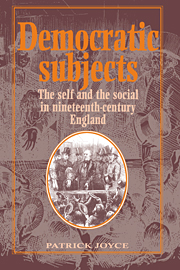Book contents
- Frontmatter
- Contents
- List of plates
- Acknowledgements
- Introduction
- Part One The sorrows of Edwin Waugh: a study in ‘working-class’ identity
- Part Two John Bright and the English people: a study in ‘middle-class’ identity
- Part Three Democratic romances: narrative as collective identity in nineteenth-century England
- 12 Narrative and history
- 13 The romance of improvement
- 14 The aesthetic framing of the social
- 15 The constitution as an English Eden
- 16 The story of the cruel Turk
- 17 Some democratic leading men, or Mr Gladstone's dream
- Appendices
- Index
14 - The aesthetic framing of the social
Published online by Cambridge University Press: 10 December 2009
- Frontmatter
- Contents
- List of plates
- Acknowledgements
- Introduction
- Part One The sorrows of Edwin Waugh: a study in ‘working-class’ identity
- Part Two John Bright and the English people: a study in ‘middle-class’ identity
- Part Three Democratic romances: narrative as collective identity in nineteenth-century England
- 12 Narrative and history
- 13 The romance of improvement
- 14 The aesthetic framing of the social
- 15 The constitution as an English Eden
- 16 The story of the cruel Turk
- 17 Some democratic leading men, or Mr Gladstone's dream
- Appendices
- Index
Summary
The thinking and framing of the social shape of power is valuably approached through an understanding of the ‘structures of imagination’ apparent in the aesthetic realm. Frederic Jameson and others have argued the significance of this realm and shown some of its effect. If narrative is as powerful a principle of ontology as theorists of narrative tell us then it follows that it may be a productive means of reconstituting the imaginative structures in question. It is in this hope that the aesthetic is explored here. The emphasis on framing and structure recalls the earlier emphasis on the agency, or efficacy, of the form, though not in any formalistic sense. The social world is categorised in certain ways, and can only be present to us as some kind of configuration of categories. These configurations are always changing, yet there are decided limits to how we see our worlds. One example, drawn from Walkowitz's recent work on sexual narratives in Victorian London, is that of melodrama. The melodramatic constructions of feminist propaganda in the 1880s were only capable of imagining women in a certain way, as a victim, exhibiting modesty, and so on. And this way was extraordinarily important over a long period. Yet it too, in the end, lost effectiveness as other aesthetic frames displaced the melodramatic, chiefly that of realism.
- Type
- Chapter
- Information
- Democratic SubjectsThe Self and the Social in Nineteenth-Century England, pp. 176 - 191Publisher: Cambridge University PressPrint publication year: 1994
- 2
- Cited by



